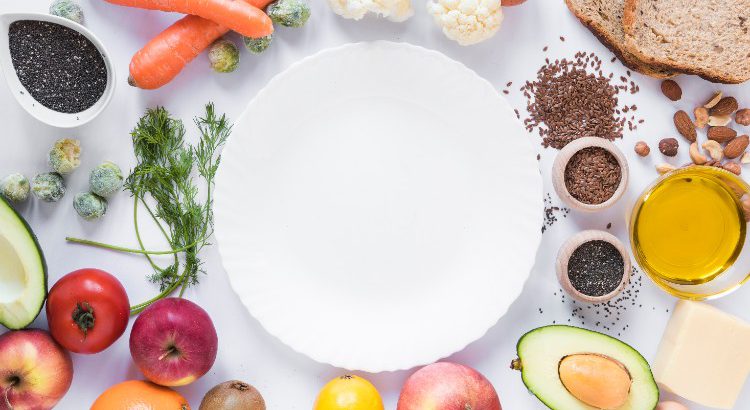After Cancer articles address topics for those in survivorship. This month, dietitian Mindy Athas shares information about National Nutrition Month.
National Nutrition Month is a nutrition education and information campaign created by the Academy of Nutrition and Dietetics (AND). It focuses on making informed food choices and developing sound eating and physical activity habits.
This year’s theme is “Personalize Your Plate” and includes tips, resources, recipes and ideas to get you healthy in 2021.
Research shows that nutrition counseling, also called Medical Nutrition Therapy (MNT), is critical in treating people with chronic disease and illness, but is also helpful for those working on weight management or other healthy habits.
Finding a registered dietitian nutritionist in your area is easy: just head to the AND website. Carroll Hospital has dedicated outpatient nutrition services. The William E. Kahlert Regional Cancer Center on the Carroll Hospital campus also has an oncology dietitian available.
Check out these National Nutrition Month 2021 Personalize Your Plate Tips:
1. Smart Tips for Successful Meals: Keep shelf-stable beans, peas and lentils, canned vegetables with no added salt, pouches or cans of fish and chicken, healthy oils, herbs and spices in your pantry. Look for ancient or intact greens such as quinoa, oats, millet, amaranth and teff, which offer three or more grams of fiber per serving. Fiber helps keep you full and can reduce risks for chronic illness.
Meal prep ideas:
https://www.eatingwell.com/article/290737/30-days-of-healthy-meal-prep/ https://sweetpeasandsaffron.com/how-to-meal-prep/
2. Eating Right for a Healthy Weight: Focus on the big picture rather than short term weight loss. Set healthy, realistic goals to improve your long-term success. Start with one or two specific small changes at a time, and track your progress. Smartphone or online tracking tools are easy to use: try My Fitness Pal, Lose It!, Fat Secret or Spark People. Focus on fruits, vegetables (including salads), high fiber grains and healthy fats like nuts, seeds, avocado, olive oil, fish and seafood. Take your time: Your brain needs 15 to 20 minutes to realize you started to eat, so slow down and chew your food well. Chewing also helps with satiety, a feeling of fullness and satisfaction that can lead to eating less at the next meal.
Weight management tips:
https://www.trifectanutrition.com/blog/how-to-maintain-weight-loss-12-tips-backed-by-science
3. Eating Right with Less Added Sugars: Added sugar is placed into almost all commercially prepared foods and drinks because it makes people eat more, eat and drink faster, and go back for more. There are no guidelines on how much added sugar can be placed into foods at this time. The American Heart Association (AHA) recommends that all adults limit added sugars to less than 36 grams (g) per day. 1 teaspoon is 4 g of sugar and most people eat 80 g or more in a day without even realizing it! Look on the Nutrition Facts panel on any packaged foods and drinks to find the total sugar in grams (g). Pay attention to the next line below that: “Includes Added Sugar” in grams (g). Add up the total daily intake of added sugar you’re taking in from all sources and aim to keep it below 36 g.
For more information on added sugar:
https://www.fda.gov/food/new-nutrition-facts-label/added-sugars-new-nutrition-facts-label
For low sugar recipes:
https://www.tasteofhome.com/collection/low-sugar-recipes/
4. Eating Right on a Budget: You don’t have to spend a lot of money to eat healthy. Use frozen vegetables without added salt or frozen fruit without added sugar. Buy fruits and vegetables on sale and in season. Look for specials on beans, soups with vegetables in them, deals on bags of salads or other plant-based items that you can get on sale. If you’re buying in bulk, consider making homemade soups, stews, chili, casseroles and slow cooker dishes that you can freeze.
For tips on low-cost eating and recipes: https://www.foodnetwork.com/healthy/photos/budget-friendly-healthy-dinners
5. Smart Ways to Make Physical Activity Part of Your Day: Exercise doesn’t have to be anything formal! Just move more and sit less. Break up sedentary or sitting time with a stretch or walk every 30 to 60 minutes. Set an alarm to remind you or get a fitness tracker. Do some wall push-ups, leg lifts or chair exercises. Try a few yoga or Pilates moves, perfect a plank or do a couple sit-ups. The goal is 10 minutes or more of cardiovascular activity, working up to three times a day most days of the week. Then add some resistance or muscle training exercises that use repetitive movements to improve your strength and mobility. Flexibility and balance can be achieved by standing on one foot while you’re brushing your teeth or cooking, going up and down on your toes, or even walking backward for a short time in a safe space.
For more activity tips:
https://www.moneycrashers.com/indoor-at-home-exercises-without-equipment/
Mindy Athas, R.D.N., C.S.O., L.D.N., is the outpatient dietitian nutritionist and certified specialist in oncology nutrition for Carroll Hospital’s Tevis Center for Wellness and the William E. Kahlert Regional Cancer Center.
